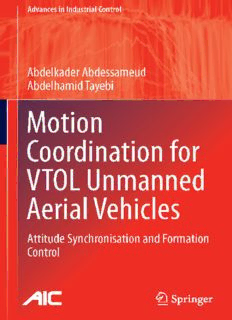
Motion Coordination for VTOL Unmanned Aerial Vehicles: Attitude Synchronisation and Formation Control PDF
Preview Motion Coordination for VTOL Unmanned Aerial Vehicles: Attitude Synchronisation and Formation Control
Advances in Industrial Control Forfurthervolumes: www.springer.com/series/1412 Abdelkader Abdessameud (cid:2) Abdelhamid Tayebi Motion Coordination for VTOL Unmanned Aerial Vehicles Attitude Synchronisation and Formation Control AbdelkaderAbdessameud AbdelhamidTayebi DeptofElectr.&ComputerEngineering DepartmentofElectricalEngineering TheUniversityofWesternOntario LakeheadUniversity London,Canada ThunderBay,Canada ISSN1430-9491 ISSN2193-1577(electronic) AdvancesinIndustrialControl ISBN978-1-4471-5093-0 ISBN978-1-4471-5094-7(eBook) DOI10.1007/978-1-4471-5094-7 SpringerLondonHeidelbergNewYorkDordrecht LibraryofCongressControlNumber:2013940424 ©Springer-VerlagLondon2013 Thisworkissubjecttocopyright.AllrightsarereservedbythePublisher,whetherthewholeorpartof thematerialisconcerned,specificallytherightsoftranslation,reprinting,reuseofillustrations,recitation, broadcasting,reproductiononmicrofilmsorinanyotherphysicalway,andtransmissionorinformation storageandretrieval,electronicadaptation,computersoftware,orbysimilarordissimilarmethodology nowknownorhereafterdeveloped.Exemptedfromthislegalreservationarebriefexcerptsinconnection with reviews or scholarly analysis or material supplied specifically for the purpose of being entered and executed on a computer system, for exclusive use by the purchaser of the work. Duplication of this publication or parts thereof is permitted only under the provisions of the Copyright Law of the Publisher’slocation,initscurrentversion,andpermissionforusemustalwaysbeobtainedfromSpringer. PermissionsforusemaybeobtainedthroughRightsLinkattheCopyrightClearanceCenter.Violations areliabletoprosecutionundertherespectiveCopyrightLaw. Theuseofgeneraldescriptivenames,registerednames,trademarks,servicemarks,etc.inthispublication doesnotimply,evenintheabsenceofaspecificstatement,thatsuchnamesareexemptfromtherelevant protectivelawsandregulationsandthereforefreeforgeneraluse. Whiletheadviceandinformationinthisbookarebelievedtobetrueandaccurateatthedateofpub- lication,neithertheauthorsnortheeditorsnorthepublishercanacceptanylegalresponsibilityforany errorsoromissionsthatmaybemade.Thepublishermakesnowarranty,expressorimplied,withrespect tothematerialcontainedherein. Printedonacid-freepaper SpringerispartofSpringerScience+BusinessMedia(www.springer.com) To ourfamilies Series Editors’ Foreword The series Advances in Industrial Control aims to report and encourage technol- ogy transfer in control engineering. The rapid development of control technology has an impact on all areas of the control discipline. New theory, new controllers, actuators, sensors, new industrial processes, computer methods, new applications, newphilosophies...,newchallenges.Muchofthisdevelopmentworkresidesinin- dustrial reports, feasibility study papers and the reports of advanced collaborative projects.Theseriesoffersanopportunityforresearcherstopresentanextendedex- position of such new work in all aspects of industrial control for wider and rapid dissemination. Over the last decade there has been continuing research interest in the control ofunmannedvehiclesofdifferenttypesandindifferentenvironments.Thiscanbe seen in the growing accumulation of titles in the Advances in Industrial Control monograph series in which at least one such new title appears on a more-or-less yearlybasis.Theserieslistcurrentlyincludesthefollowingtitles: • Spacecraft Navigation and Guidance by Maxwell Noton (ISBN 978-3-540- 76248-5,1998); • Modelling and Control of Mini-Flying Machines by Pedro Castillo, Rogelio LozanoandAlejandroE.Dzul(ISBN978-1-85233-957-9,2005);and • Fault-tolerant Flight Control and Guidance Systems by Guillaume J.J. Ducard (ISBN978-1-84882-560-4,2009); • Control of Ships and Underwater Vehicles by Khac Duc Do and Jie Pan (ISBN 978-1-84882-729-5,2009); • UnmannedRotorcraftSystemsbyGuoweiCai,BenM.ChenandTongHengLee (ISBN978-0-85729-634-4,2011);and • Quad Rotorcraft Control by Luis R. García Carrillo, Alejandro E. Dzul López, RogelioLozanoandClaudePégard(ISBN978-1-4471-4398-7,2012). The Series Editors are also aware that new series monographs on the control ofindividualunmannedvehiclesarecurrentlyinpreparationandsocanconfidently saythatinterestinthisfieldcontinuestogrow.Drivenbynewpotentialapplications, alogicalextensionofthecontrolofasingleunmannedvehicleisformationcontrol vii viii SeriesEditors’Foreword of several such vehicles. Looking at activities in subsea, terrestrial, aerospace and deep-spaceenvironments,itisfairlyeasytofindapplicationswhereformationcon- trol would be a key requirement. Some typical examples are fleets of marine ves- selsinconvoyformation,marinevesselstravellingwhilstrefuellingistakingplace, automotive vehicles travelling in formation across terrestrial terrain—the flocking behaviourofvehiclesonmotorwayscouldevenberegardedasaformation,inspec- tionaerialvehiclestravellinginformationfromonelocationtoanother,satellitesin spacemovinginformationandwithcommonorientation,andsoon. With such possible applications, it is not surprising that there is research activ- ityinthedifferenttheoreticalaspectsofcontrolforformationsofunmannedvehi- cles. Howeverthere appear to be few monographs in this field and the Series Edi- tors are pleased to add the monograph Motion Coordinationfor VTOL Unmanned Aerial Vehicles: Attitude Synchronization and Formation Control by Abdelkader AbdessameudandAbdelhamidTayebitotheAdvancesinIndustrialControlseries. In this work, the authors take a general rigid-structure-modelling approach adapt- abletounmannedvehicleslikesatellites,andvarioustypesofverticaltake-offand landingunmannedvehiclessuchasquad-rotorcraftandducted-fanaerialvehicles. They seek solutions to two control problems: attitude synchronisation, typically a satellite-orientationproblemandformation-positioncontrol.Theauthorsthenpro- ceedtoaddtotheproblemdescriptionpracticalconstraintsarisingfromincomplete informationandcommunicationdelays,whichareoftendestabilizinginrealappli- cationscenarios,andtodeviseappropriatecontrolsolutions. Theauthorshavebeenresearchingthisfieldforsometimeandarepresentinga thorough and complete synthesis of their research work in this monograph. A lit- tle background on the authors may interest the reader. Abdelkader Abdessameud received his PhD in Electrical and Computer Engineering from the University of WesternOntario,CanadaandatthetimeofwritingisaPost-DoctoralResearchFel- lowintheDepartmentofElectricalandComputerEngineeringattheUniversityof Western Ontario, Canada. His research interests lie in the theory and applications ofnonlinearcontrol.AbdelhamidTayebiispresentlyaProfessorintheDepartment of Electrical Engineering at Lakehead University, Canada. He is the founder and DirectoroftheAutomaticControlLaboratoryatLakeheadUniversity.Hisresearch interests are mainly related to linear and nonlinear control theory including adap- tivecontrol,robustcontrolanditerativelearningcontrol,withapplicationstorobot manipulatorsandaerialvehicles. The Editors welcome this monograph into the Advances in Industrial Control seriesandfeelitwillappealtoresearchersandindustrialengineersintheaerospace fields.Themonographshouldalsobeofinteresttopractitionersofnonlinearcontrol theoryanditsapplications. IndustrialControlCentre, M.J.Grimble Glasgow,Scotland,UK M.A.Johnson Preface Thebookaddressesthecoordinatedmotioncontrolproblemofateamofunmanned aerialvehicles(UAVs).Theproblemisparticularlychallengingduetothecomplex nonlineardynamicsgoverningthistypeofsystems,whichareoftenunderactuated. Assuch,coordinatedcontrolschemesdevelopedforlinearmulti-agentsystemscan- not be directly applied to this type of systems. This has motivated our research in thisareainthepastfewyears.Inparticular,wewereinterestedintheattitudesyn- chronizationproblemofmultiplerigid-bodysystemsandtheformationcontrolofa classofUAVswithverticaltake-offandlandingcapabilities,referredtoasVTOL UAVsforshort. Theattitudesynchronizationproblemisgenerallyconsideredindeepspaceap- plications where replacing traditionally large and complex spacecraft with clus- ters of simpler micro-satellites was shown to present several advantagesregarding mission performance and cost. In the majority of the current research relevant to spacecraft attitudesynchronization,it is assumed that the state variables are avail- ableforfeedback.Designingefficientcontrollerswithaminimumnumberofmea- suredstatevariablesisacommontheoreticalchallengeyetwithimportantpractical implications. It is of a great interest to design controllers that do not involve the measurements of some crucial variables that require complex, expensive, and/or prone-to-failuresensors.Fromthisperspective,thedesignofattitudesynchroniza- tion schemes without velocity measurements stands out as an important and chal- lengingproblem. VTOLUAVsincludeseveraltypesofthrustpropelledaircraftsuchashelicopters, quadrotor,andductedfanvehicles.Theyconstituteanimportantclassofflyingsys- tems due to their ability to hover and maneuver in confined or restricted environ- ments.Thismakesthemsuitableforabroadrangeofapplicationsrequiringstation- aryflightssuchassurveillance,searchandrescuemissions,andmonuments/bridge inspection.Thecoordinatedcontrolofthisclassofunderactuatedmechanicalsys- temsisquitechallenging,especially,whensomestatevariablesarenotavailablefor feedback. Informationexchangebetweenaircraftinvolvedintheformationplaysanimpor- tantroleinachievingasuccessfulmotioncoordination.Thisinformationexchange ix x Preface is generally subject to delays that are inherent in communicationsystems. The ef- fectsofcommunicationdelaysinlinearmulti-agentsystems,withfirstandsecond orderdynamics,havebeendiscussedinmanyinterestingresearchpapers.Theap- plication of these results to the attitude synchronization of spacecraft is hampered by the complex nonlinear attitude dynamics of a rotating rigid body. In addition, theunderactuatednatureofVTOLUAVsintroducesseveralcontroldesigndifficul- ties. Moreover, in most of the research dealing with multi-agent systems, delayed communicationisonlyconsideredinthefullstateinformationcase.Thiswasamo- tivating factor for the development of new approaches that handle communication delays in the case where only part of the system state variables are available for feedback. Our objective in writing this research monograph is to summarize our recent developmentsrelatedtocoordinatedcontrolproblems.Differentcontroldesignap- proachesfortheattitudesynchronizationproblemarepresented.Thesynchroniza- tionschemesrequireonlyattitudemeasurementsandtheneighbor-to-neighborin- formationexchange,whichcanbedelayed.Inaddition,byintegratingnewcontrol designtechniqueswithsomeconceptsfrommulti-agentsystems,anewtheoretical frameworkisdevelopedforthemotioncoordinationofVTOLUAVs. Thebookisprimarilyintendedtoresearchersandengineersfromrobotics,con- trol engineering, and aerospace communities. It also serves as a complementary readingforgraduatestudentspursuingresearchinthesefields. London,Ontario,Canada AbdelkaderAbdessameud ThunderBay,Ontario,Canada AbdelhamidTayebi Acknowledgements Weareindebtedtoallthosewhocontributedtotheconcretizationofthisbookand inparticulartotheNationalSciencesandEngineeringResearchCouncil(NSERC) ofCanadaforfinancialsupport.WewouldliketothankIliaPolushinandAndrew Robertsforthefruitfultechnicaldiscussions.WewouldalsoliketothankMichael Johnson(JointEditor,AICSpringer)andOliverJackson(Editor,Springer)fortheir support and guidance during the preparation of this manuscript. In addition, ac- knowledgment is given to the Institute of Electrical and Electronic Engineering (IEEE)andElsevierforgrantinguspermissionstoreproducesomeofthematerial wepreviouslyreportedinthepaperslistedbelow. AbdessameudA,TayebiA(2008)Attitudesynchronizationofaspacecraftforma- tionwithoutvelocitymeasurement.In:Proceedingsofthe47thIEEEConference onDecisionandControl,pp.3719–3724,©2008IEEE. AbdessameudA,TayebiA(2009)Attitudesynchronizationofagroupofspace- craft without velocity measurements. IEEE Transactions on Automatic Control 54(11):2642–2648,©2009IEEE. Abdessameud A, Tayebi A (2009) On the coordinated attitude alignment of a group of spacecraft without velocity measurements. In: Proceedings of the 48th IEEE Conference on Decision and Control, pp. 1476–1481, ©2009 IEEE. Abdessameud A, Tayebi A (2009) Formation control of VTOL UAVs. In: Pro- ceedingsofthe48thConferenceonDecisionandControl,pp.3454–3459,©2009 IEEE. Abdessameud A, Tayebi A (2010) Formation control of VTOL UAVs without linear-velocitymeasurements.In:ProceedingsoftheAmericanControlConfer- ence,pp.2107–2112,©2010IEEE. AbdessameudA,TayebiA(2010)FormationstabilizationofVTOLUAVssub- ject to communication delays. In: Proceedings of the 49th Conference on Deci- sionandControl,pp.4547–4552,©2010IEEE. xi
Description: